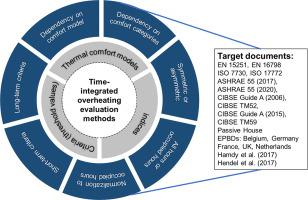Energy and Buildings ( IF 6.6 ) Pub Date : 2021-09-17 , DOI: 10.1016/j.enbuild.2021.111463 R. Rahif 1 , D. Amaripadath 1 , S. Attia 1

|
Overheating exposure over time can lead to discomfort, productivity reduction, and health issues for the occupants in buildings. The time-integrated overheating evaluation methods are introduced to describe, in a synthetic way, the extent of overheating over a span of time and predict the uncomfortable phenomena. This paper reviews the time-integrated overheating evaluation methods that are applicable to residential buildings in temperate climates of Europe. We critically analyze the methods found in (i) 11 international standards, namely, EN 15251 (2006), EN 16798 (2019), ISO 7730 (2004), ISO 17772 (2017–2018), ASHRAE 55 (2017), ASHRAE 55 (2020), CIBSE Guide A (2006), CIBSE TM52 (2013), CIBSE Guide A (2015), CIBSE TM59 (2017), and Passive House (2015), (ii) five national building codes based on the Energy Performance of Building Directive (EPBD) in Belgium, France, Germany, the UK, and the Netherlands, and (iii) two studies in the scientific literature. For each method, we present the thermal comfort models along with the time-integrated overheating indices and criteria. The methods are analyzed according to some key measures in order to identify their scope, strength, and limitations. We found that most standards recommend the static comfort models for air-conditioned buildings and the adaptive comfort models for non-air-conditioned ones. We also found a promising method based on three indices, namely, Indoor Overheating Degree (IOD), Ambient Warmness Degree (AWD), and overheating escalation factor () that allows for a multi-zonal and climate change-sensitive overheating assessment. Finally, some guidance is provided for practice and future developments.
中文翻译:

欧洲温带气候下住宅建筑的时间综合过热评估方法评述
随着时间的推移,过热暴露会导致建筑物中的居住者感到不适、生产力下降和健康问题。该时间积分过热的评价方法引入以综合方式描述一段时间内过热的程度并预测不舒服的现象。本文综述了适用于欧洲温带气候住宅建筑的时间积分过热评估方法。我们批判性地分析了 (i) 11 项国际标准中的方法,即 EN 15251 (2006)、EN 16798 (2019)、ISO 7730 (2004)、ISO 17772 (2017–2018)、ASHRAE 55 (2017)、ASHRAE (2020)、CIBSE 指南 A (2006)、CIBSE TM52 (2013)、CIBSE 指南 A (2015)、CIBSE TM59 (2017) 和被动房 (2015),(ii) 五个基于能源性能的国家建筑规范比利时、法国、德国、英国和荷兰的建筑指令 (EPBD),以及 (iii) 两项科学文献研究。对于每种方法,我们提出了热舒适模型以及时间积分过热指数和标准。根据一些关键措施对这些方法进行分析,以确定它们的范围、优势和局限性。我们发现大多数标准推荐空调建筑采用静态舒适模型,非空调建筑采用自适应舒适模型。我们还发现了一种基于三个指标的有前途的方法,即室内过热度(IOD )、环境温暖度 ( AWD ) 和过热升级因子 () 允许进行多区域和气候变化敏感的过热评估。最后,为实践和未来发展提供了一些指导。










































 京公网安备 11010802027423号
京公网安备 11010802027423号